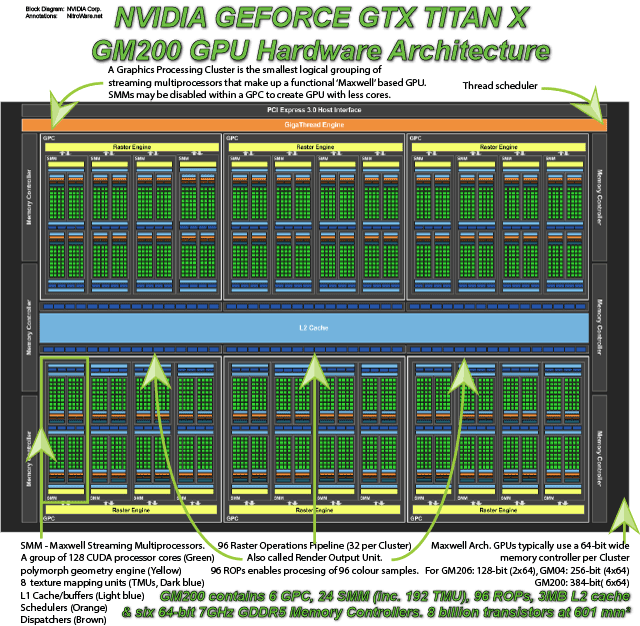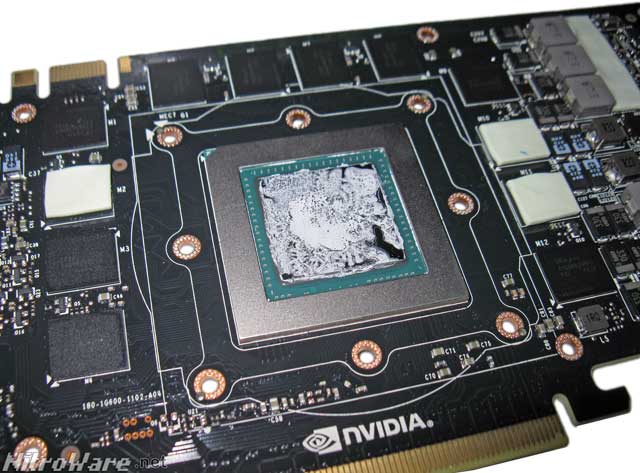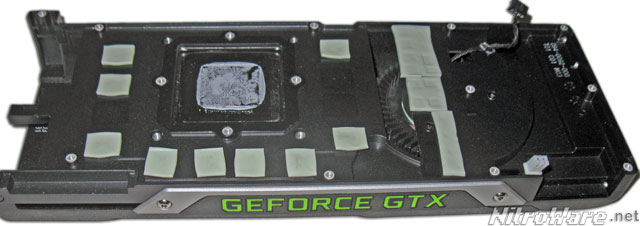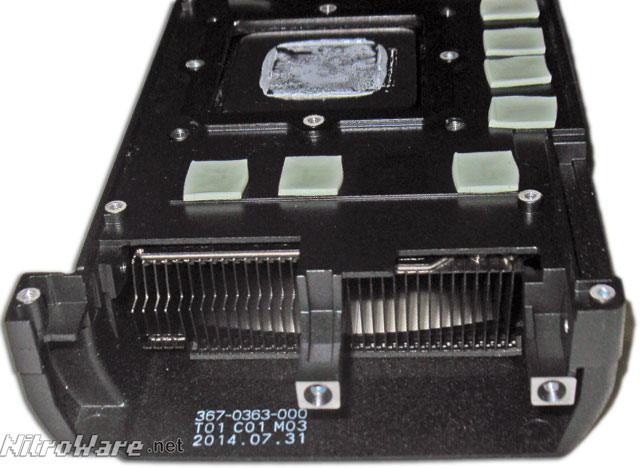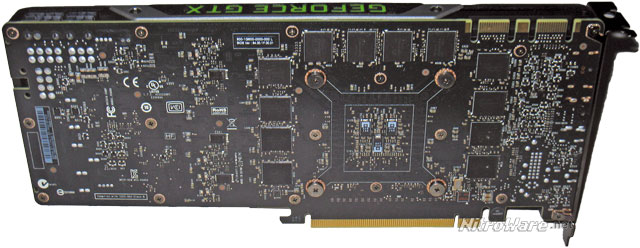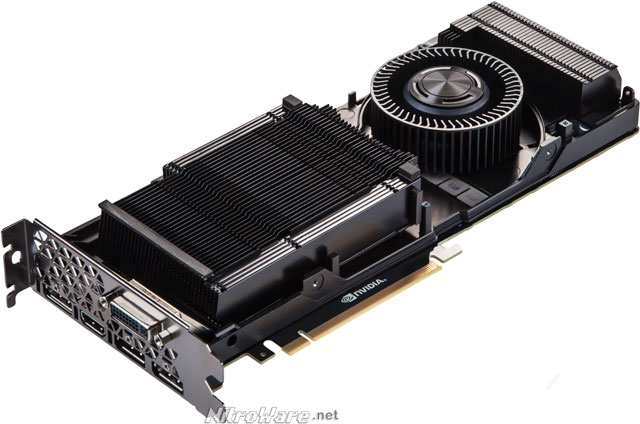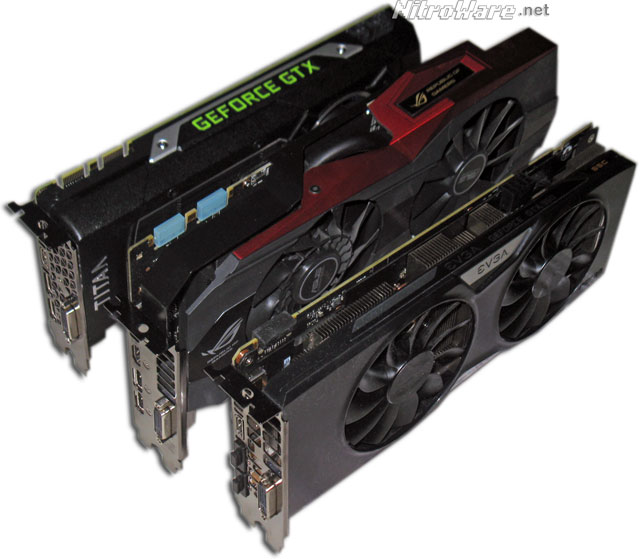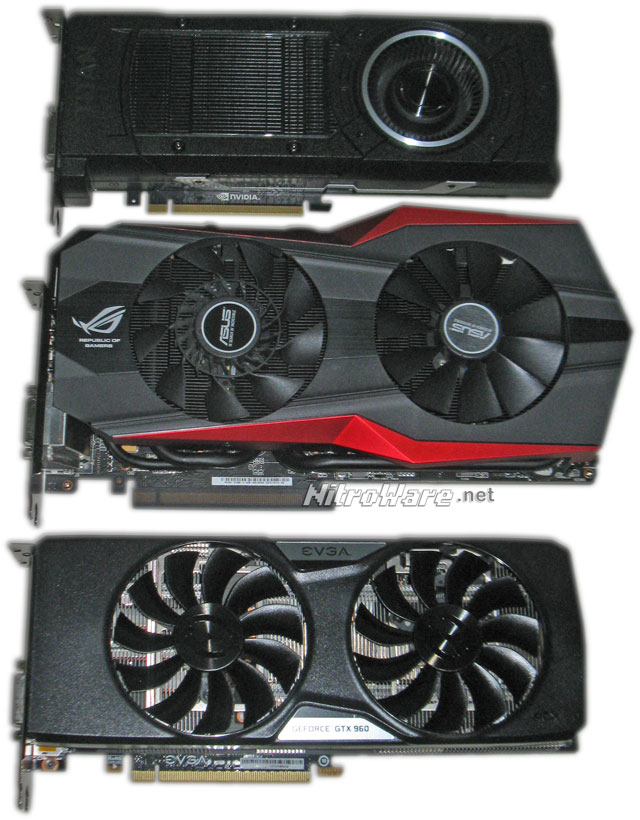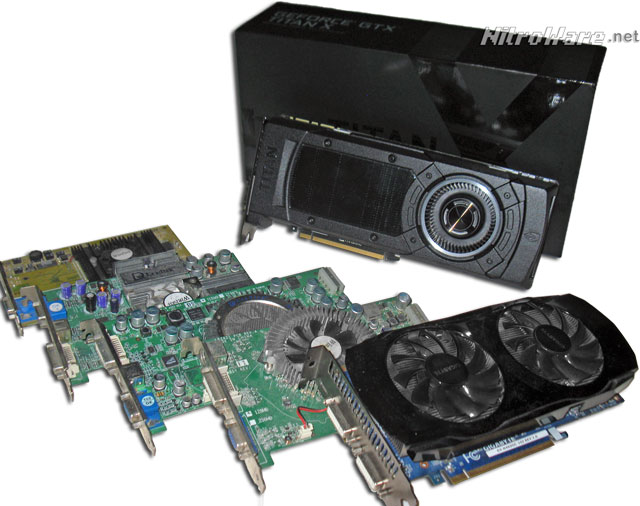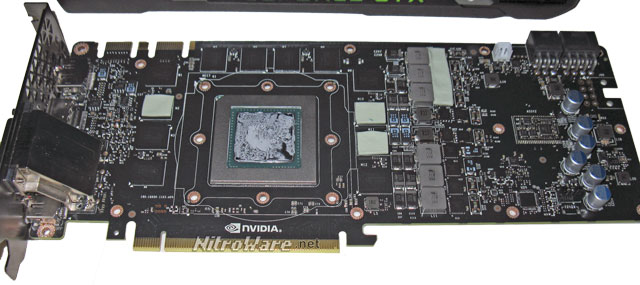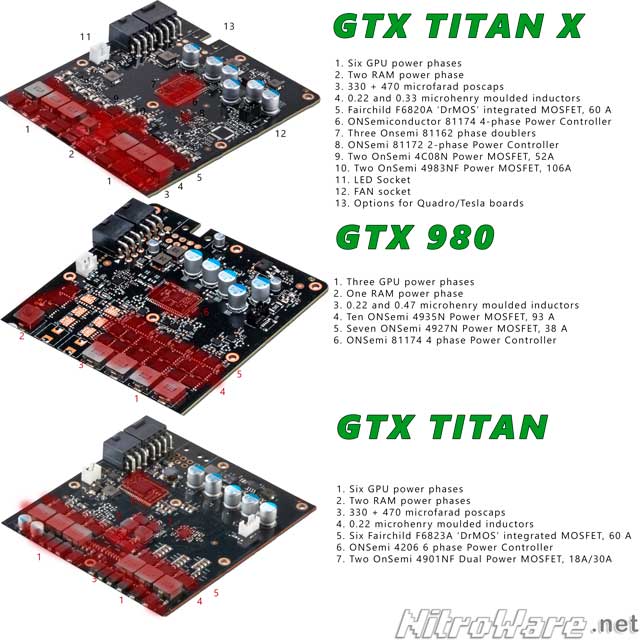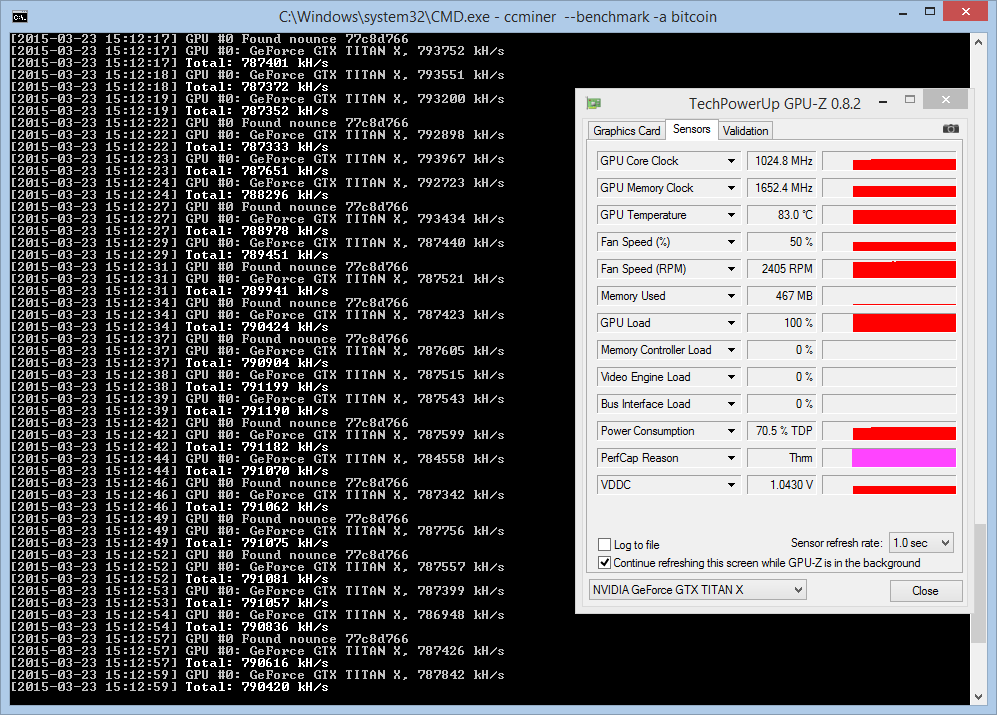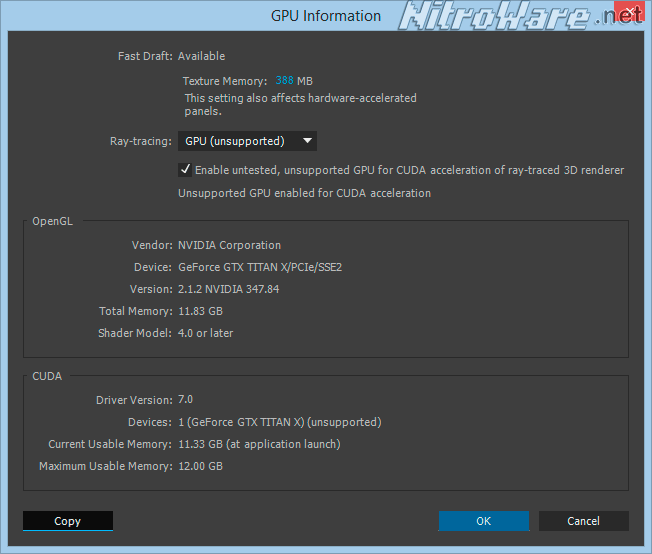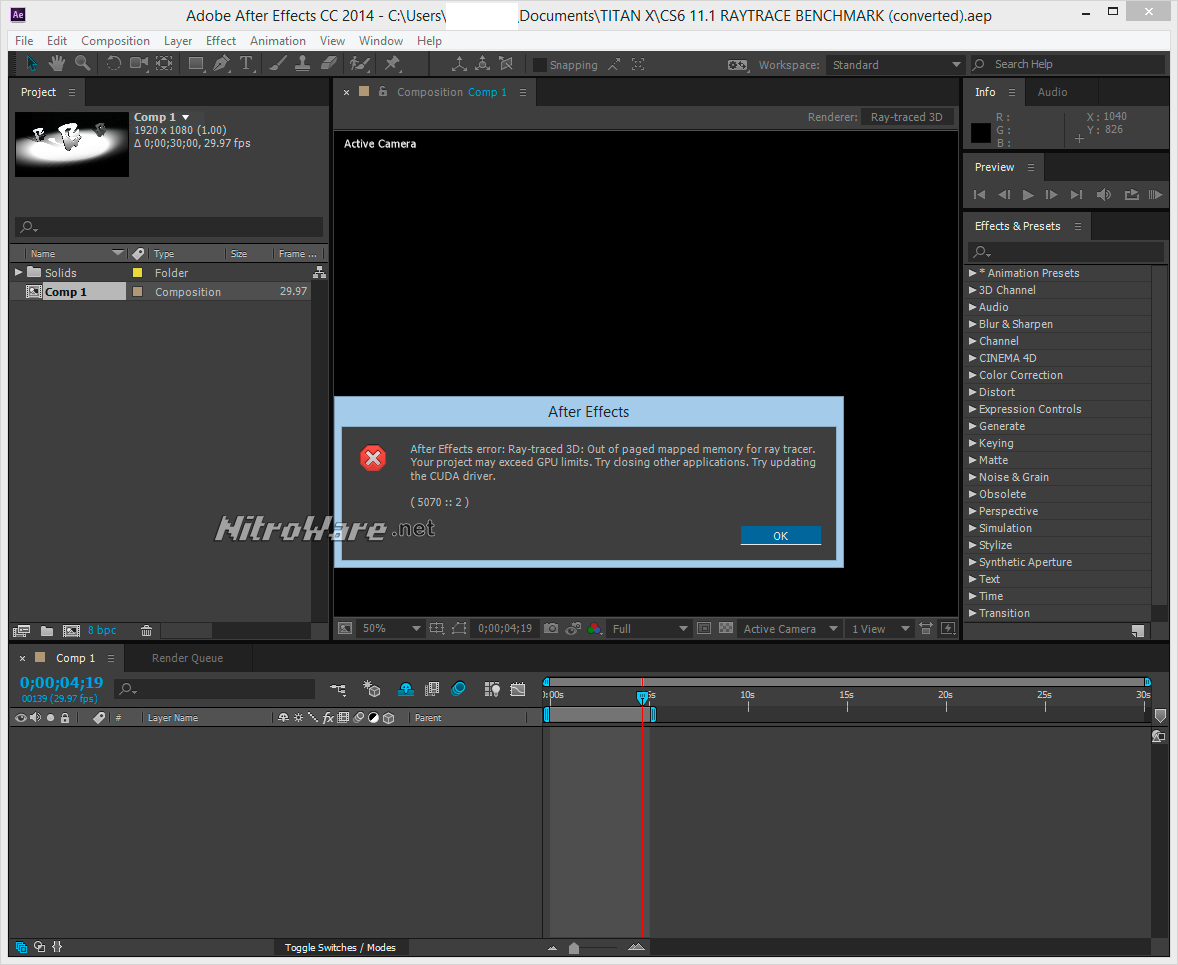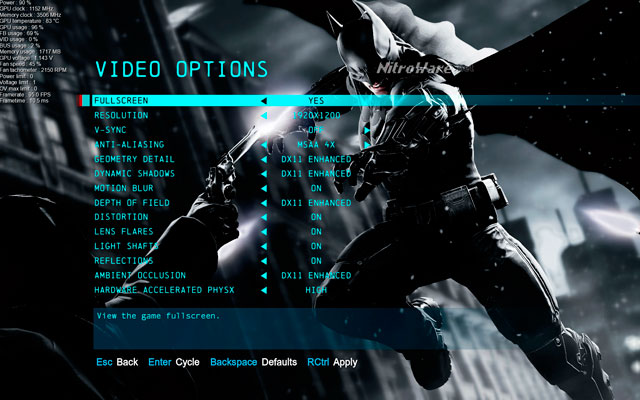TITAN X Marks the performance Spot
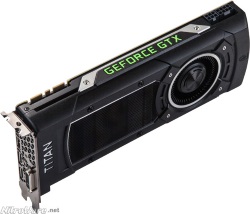 At 7 TeraFlops of compute performance, claiming to be the 'worlds's fastest GPU' the single GPU TITAN X board has big shoes to fill if it wants to also take the title of worlds fastest gaming graphics card from AMD's Dual GPU, Liquid Cooled 11.5 TeraFlop Radeon R9 295 X2.
At 7 TeraFlops of compute performance, claiming to be the 'worlds's fastest GPU' the single GPU TITAN X board has big shoes to fill if it wants to also take the title of worlds fastest gaming graphics card from AMD's Dual GPU, Liquid Cooled 11.5 TeraFlop Radeon R9 295 X2.
Older NVIDIA TITAN boards were infamous for their large video memory, double precision floating point calculation and over the top pricing. Armed with Maxwell's utility belt features of Multi-Frame Anti-Aliasing, Voxel Global Illumination, display flexibility and high efficiency. NVIDIA is trying to take the new GM200 chip and TITAN X board in a different direction, aiming at users of VR and multiple 4K displays rather than a entry level board for high precision GPU Computing.
TITAN X combined with Intel's 4th Gen Haswell-E CPU and X99 platform delivers smooth frame rates at Ultra Details when paired with a 4K 60Hz display, in addition to being power efficient. Drawing 300W typical at the wall in popular titles such as Battlefield 4, Batman Arkham Origins and Crysis 3. For now, GM200 and TITAN X is the fastest single GPU money can buy but as history tells is this wont be the case for long.
GeForce GTX TITAN History and Overview
To 'hardcore' PC Enthusiasts, a GeForce GTX TITAN needs no introduction. In NVIDIA's top to bottom GPU lineup the Titan takes up what used to be the 'Ultra' board that was marketed in the late 90s and through to the late 2000s. A change in marketing for product names to simply them retired the Ultra brand.
It was not until NVIDIA achieved a design with its K20 Tesla Compute cards for the 2nd fastest supercomputer in the world, the 'TITAN' supercomputer at the US Department of Energy Oak Ridge Tennessee Labs, that the firm realised it needed to return an iconic brand to its flagship consumer GPUs.
The TITAN name stuck and from a technology perspective 'TITAN' was more a relevant and meaningful brand than 'Ultra' as at the time. The TESLA K20 Compute cards shared the same 'Kepler' architecture GK110 GPU as the pro-sumer oriented GeForce GTX TITAN board, with the name connecting the two applications.
The 'X' in Titan X actually stands for Maxwell, and is not a confusion compared to the Dual Kepler TITAN Z. The naming follows how Tegra K1/X1 are named after their respective Kepler and Maxwell architectures.
Like the first Titan which featured the 'large' GK110 GPU, 6GB of Memory, High Speed Double-Precision floating point and a high quality cooler, Titan X is also the introduction of the 'large' 3072 CUDA core GM200 GPU. Designed for optimal single precision performance, NVIDIA claims Maxwell based Titan X delivers 2X performance and 2X efficiency of the original Kepler-based Titan (when considering that the new Multi-Frame Anti-Aliasing method is used).
| Card | GTX TITAN | GTX TITAN Black | GTX 980 | GTX TITAN X | R9 290X |
|---|---|---|---|---|---|
| Pixel Fillrate (GP/s) | 40 | 43 | 72 | 96 | 64 |
| Texture Fillrate (GT/s) | 188 | 213 | 144 | 192 | 176 |
| Memory Bandwidth (GB/s) | 288 | 336 | 224 | 337 | 320 |
| Single Precision Compute (GFLOPS) | 4500 | 5121 | 4612 | 6630 | 5632 |
| Double Precision Compute (GFLOPS) | 1500 | 1707 | 144 | 192 | 704 |
| Single Precision Efficiency(GFLOPS/Watt) | 18 | 20.5 | 28 | 24.6 | 19.4 |
-
CUDA/Shader core count between Kepler 'SMX' and Maxwell 'SMM' modules on the GPU should not be compared due to architectural differences.
-
Dual GPU GTX TITAN Z board omitted for clarity, specs are slightly less than two TITAN Black
-
GTX TITAN X retains 1/32 double precision performance of GeForce
-
TFLOPS is calculated as 2x core count x clock speed. For Titan X we took the Boost clock. 2x 3072 x 1089 = 6.63 TFLOPS which correlates to NVIDIA's stated 7 TFLOPS. Other values are from wikipedia which uses base clock for calculation.
Comparing NVIDIA GTX and AMD's flagship R9 290X, NVIDIA excels in performance per watt while AMD aims for Compute Performance. On paper, GM200 is the most powerful single GPU on the market today. GTX 980 despite having less cores, has high clockspeeds hence excels at performance per watt over the Titan X, however Titan X is still faster and more powerful.
If overclocked to 1400 MHz from its base 1000 MHz speed, Titan X will achieve 8.6 TFLOPS single precision computation performance.
For our review in addition to the reference NVIDIA built GTX 980 board, we also used an ASUS Republic of Gamers Matrix Platinum GTX 980, which features beefed up power circuits, cooling and a 10% increase in fill-rates above the reference card.
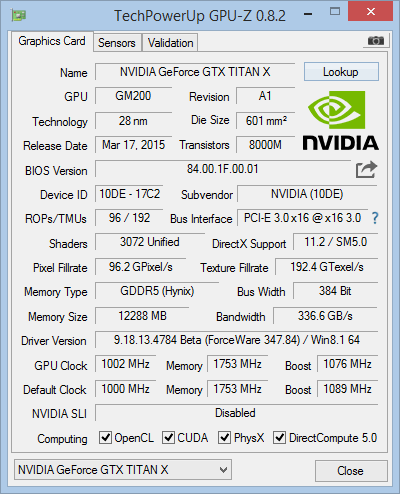
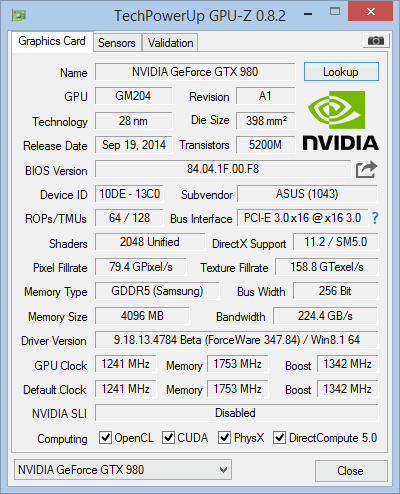
What's new with TITAN X - Architecture and Features
Maxwell GM200 GPU Architecture
GM200 carries over the same DirectX 12 Feature level 12.1 micro-architecture used in GM204 (GTX 980/970) and GM206 GTX 960
This time around, the compute clusters have been scaled up to meet the performance requirements, otherwise the arch is unchanged, including retention of double-precision instruction throughput being 1/32 the rate of single-precision.
Understanding the logical and physical blocks that make up a modern programmable GPU can be difficult and confusing which is why we prefer to explain this concept with an annotated diagram.
This describes the compute units only. missing are auxiliary circuits and microprocessors that manage power, displays and video decoding/encoding.
The chip itself is on the verge of being the largest practically manufacturable GPUs in large quantities. NVIDIA has shipped large chips before in the 550-575mm2 range but at 600, the rocket that is GM200/TITAN X has reached new heights. Intel's Xeon Phi 'Knights Corner' and 18-Core E5 Xeon CPUs size up between 650 and 700mm2
The larger size means more transistors, 8 bilion compared to 7.1 billion for the previous flagship GK110 NVIDIA chip. More transistors means more heat. How NVIDIA managed to keep power and temperature in check is thanks to tuning of their GPU Boost technology and insistence on efficiency and performance per watt.
Double Precision Floating Point Math Computation Performance and 12 GB of memory
End users in HPC, Research and Science fields who need this level of precision are expected to buy an older Titan or a professional series Quadro or Tesla NVIDIA card. NVIDIA cites two reasons for this change, that they would like to keep their professional Tesla and consumer GeForce product lines separate, which older TITAN was somewhat cannibalising plus adding double precision hardware support to the shader compute cores would have taken up too much die area which could have been used for other purposes such as enhancing single precision performance/rendering.
While this may seem nefarious considering some cash strapped students have relied on TITAN in the past as an affordable High Speed Double Precision compute device, In a way, NVIDIA's fortunes in its professional segment actually help the consumer segment by helping keeping prices in check and encourage consumer oriented development. A healthy NVIDIA with solid revenues from its professional products is a good thing for everyone, even pushing their competition AMD to produce better products and Intel to produce more powerful many-core Xeon Phi chips. A weak market overall can inhibit innovation and encourages rebranding and clearing of inventories of slow moving products.
Double Precision the biggest change to TITAN for 2015, but its large 12GB frame buffer is not a new concept, Quadro K6000 featured 12GB and some Tesla boards also feature large frame buffers but it is a first for a gaming graphics card. 12GB is just about right as a future proof size, roughly supporting three 4K/Ultra HD displays and future proofing for Multiple 5K and higher. A note on this however is since Maxwell does not support DisplayPort 1.3, two of TITAN X's 'DisplayPort 1.2 connectors are needed to drive a single 5K display, of which the board only has three in total.
The memory itself is nothing unique and follows NVIDIA's standards. The 3072 cores means more memory controllers and more bandwidth, so it is great to see the return of awesome memory bandwidth (plus compression) to a GeForce. SK hynix does offer the same memory in a double density, so we may be seeing 24 GB GeForce cards in the future.
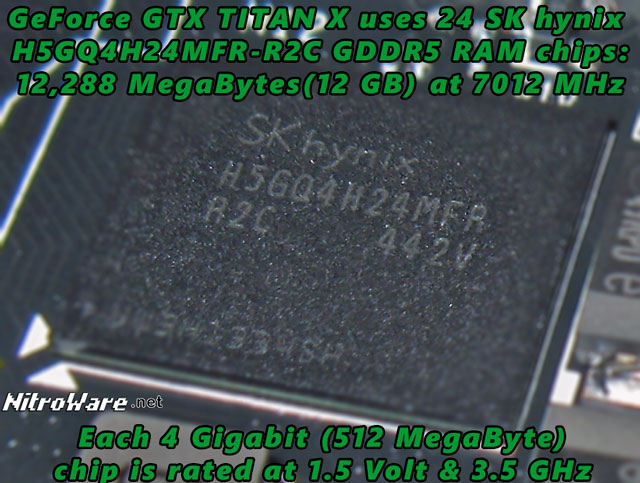
Cooling System
Carried over is TITAN's famous silver heatsink cover and vapour chamber based cooling system. To uniquely identify the TITAN X, it's aluminium cover is painted black. The black shroud is the only real tell-tale to compare a Titan X to other NVIDIA cards,even the previous TITAN Black is still silver while the GTX 980 has its unique finned backplate
Speaking of that backplate, it's gone. It had several purposes on GTX 980. To heatsink the back of the card, to protect the backside components and as an aesthetic cover to stealth the 'ugly' backside components of the card. We received conflicting information on why it was removed. One area of NVIDIA contact said it was purely to maximise airflow in 3 and 4 way SLI configurations, another said end users were forgetting to removing the detachable airflow vent from the backplate of their GTX 980s. The truth is somewhere in the middle and for a flagship card it would have been nice to see a backplate especially as there is 6GB of memory on the backside of the card.
Cooling wise NVIDIA actually does not have to do anything radical to the cooling solution as the thermal envelope of the generational cards has not changed much. What we call NVIDIA's 'silver' cooler was originally designed for and capable of cooling above 250 watts, with only fan speeds varying to suit particular sizes of GPUs. On Titan X the cooler needs to handle 275 watts when it is set to its maximum 110% power limit. We have had 250 Watt high end NVIDIA Kepler cards before so thermal envelopes of those boards are known, and if we add the efficiency of the Maxwell architecture to the mix we gain a bit more headroom as performance makes up for some power savings.
Board Aesthetics and Visual Look.
Look is only really an issue to some users, especially enthusiasts have the desire to show off their hardware especially with a case window, as the side LED of the card still says GEFORCE GTX in backlit green LED as do its siblings, a minor point but flagship aesthetics for a flagship price is also an excuse used at times.
It is a far point that buying the best gaming graphics card, you should be able to show it off and it should look the part especially for the price, where as a board for scientific computing is not about look.
The card has no other aesthetic or LED features, however media samples did ship in same style of collectors 'shoebox' that the GTX 980 shipped in and this time it seems NVIDIA have adopted this packaging as a retail box as it features the full product specs and certification on the bottom. The box sets the card apart form others on a shelf but its of course up to Add-In-Board partners to decide whether to use it. Some users would be happy if these expensive cards just shipped in brown cardboard though. The ASUS ROG GTX 980 we used in this review however, is basically padding.. The bigger the box,well you can figure the rest out.
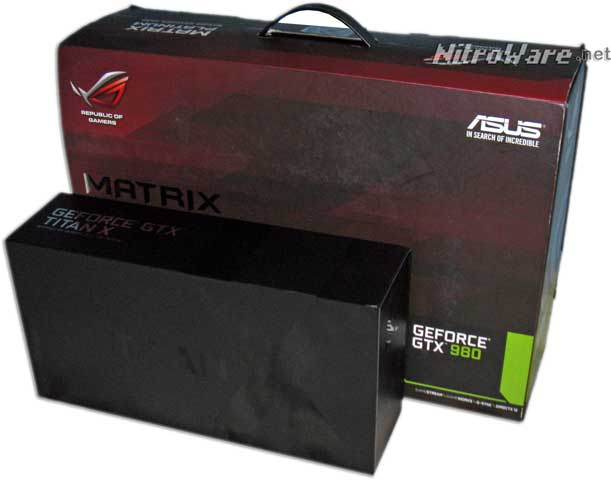
Compared to older cards such we have shown however it does look the part. Personally the black feels slightly 'cheap' to me and reminds me of the reference coolers of cheaper cards such as the 480, 660 and 680 but I am growing to like it especially as its metal not plastic. TITAN X's Quadro sibling, the new M6000 certainly looks the part with its green highlights.
Reference Card Design and Optimisation
Reference cards often get a bad rap by end users and despite 'silver' series GeForces running well, some enthusiasts call them out based on their manufacturing/design origin, component selection and and a number of unpublishable terms based on armchair assumptions. Unfairly, reference cards often get compared to over the top engineered partner cards with massive number of power supply phases or claims about component supply. Things such as capacitor life span, type and style of inductors used ('diamond','winged','alloy') and heatpipes that have been chromed or painted amongst other design decisions that are borderline aesthetic.
The main complaints about reference cards really are cooling and coil whine. Cooling we touched on earlier, and TITAN X's Vapour Chamber cooler will keep the GPU at its max boost temperature of 83-85cc under heavy load before switching off GPU Boost (throttling down to base clock). This in itself isn't a bad thing or dangerous despite the number sounding scary.
After-market GeForce cards will offer lower load temperatures such as the ROG Matrix GTX 980 we used in this review, 10c cooler but you pay for the privilege in cost, size and weight. Remember, TITAN X like NVIDIA's other single GPU cards are all 10.5" long with side mounted power sockets, meaning they will fit in the majority of ATX compliant towers without having to remove any drive bays.
With large graphics cards, Coil whine is mainly an issue during extremely high frame rates, especially when benchmarking not so demanding titles with v-sync off. Various add-in-board partners claim that their careful selection of coils/inductors avoids this issue. NVIDIA claim they to use components (Polarised caps and Moulded Inductors)to reduce coil whine. The TITAN X does have these components on the PCB but so does the GTX TITAN and GTX 980.
In our testing experience with TITAN X, coil whine was very minor when testing very high frame rates with V-Sync off but the test PC's fans and pump were much louder and noticeable than the graphics card.
A good spot to test for coil whine is the results page at the end of JUST CAUSE 2's benchmark run. It renders at 2000 FPS with v-sync off and provides a stable frequency coil whine.
Power for the card is handled by a 6-phase power supply for the GPU itself with over-voltage support and an additional 2-phase supply for the memory. The adjustable power limit in software is only 110% or 275 watts, where NVIDIA claims any higher would breech their acoustic specifications.
The layout of the Capacitors, Inductors and Voltage Regulators on the card itself has been optimised to be more symmetrical on TITAN X compared to both the TITAN and GTX 980, this helps ensure these components receive equal and even cooling and airflow. The power supply system has been updated and upgraded. We were able to confirm the changed components.
Software Features
NVIDIA is bringing some new features via software too as the TITAN X is suited for VR with its performance and 12 GB memory. These are mostly related to Virtual Reality support (VR Direct)and Voxel Global Illumination (VXGI)
VR Direct was announced with GTX 980, and most of the software stack can be back-ported for other cards, where performance permits. A single card may perform a warp on the last rendered scene to save re-rendering the scene upon movement of the players head when using a VR headset. For performance purposes, This can be combined with two card SLI which combines alternate frame rendering,where frames for each eye are processed independently on each GPU left and right with the time warping feature.
VR Direct is being evaluated by Epic Games, Crytek, VALVE and Occulus with public drivers to be available in coming months.
Voxel Based Global Illumination, where Voxels and Tessellation work together to build up a lighting structure to enable global illumination for a 3D Scene has evolved from NVIDIA's original Apollo 11 tech demo as seen below, into actual in-game content.
Developers can now utilise VXGI with Unreal Engine 4 and based on the Apollo 11 demo and user samples we cant wait to see VXGI used in commercial game titles.
Test Specifications and Methodology
To try to eliminate a CPU and Platform bottleneck we used Intel's flagship 'extreme' high end desktop (HEDT) processor, the i7-5960X paired with a X99-A/USB 3.1 motherboard from ASUStek, their latest entry model featuring two USB 3.1 Type-A ports powered by an ASmedia controller. This future proof mainboard is an ideal match for a new future proof GPU.
NVIDIA also used the 5960X so this places things on par, however there is a small caveat here. Lightly threaded games may benefit from the additional 1GHz provided by Intel's mainstream i7-4790K and Z97 platform. We will follow this up in a subsequent review but for our launch coverage of TITAN X, we are sticking with Intel's High End Desktop Platform. as this is what NVIDIA, other sites and ourselves have used in the past to test other flagship GPUs such as AMD's Radeon HD 7970 and NVIDIA's GeForce GTX 980.
| Type | Part |
|---|---|
| CPU | i7-5960X |
| M/B | ASUS X99-A/USB 3.1 / GIGABYTE X99 G1-Gaming |
| RAM | 4x4GB Corsair Vengeance LPX DDR4-2800 @ DDR4-2133 / 4x4GB Crucial Desktop DDR4-2133 |
| SSD | Crucial M500 960GB |
| HDD | Seagate 3TB 7200 RPM |
| PSU | FSP AU-750M 750W 80GOLD |
| Cooling | Intel TS13X Liquid Cooler + 3 Corsair Case Fans |
| Chassis | Corsair C70 Vengeance Mid Tower |
| GPU | NVIDIA GTX 980, ASUS ROG Matrix Platinum GTX 980, NVIDIA TITAN X,AMD Radeon R9 290X |
| S/W | NVIDIA Drivers 344.16/347.84 Beta, |
| LCD | DELL U2412M, UP2414Q |
| OS | Windows 8.1 Pro 64-bit |
Testing was performed at 25-29 C ambient room temperature and power tests at Full HD resolution.
Benchmarks - 4K
4K gaming tests
With 4K gaming (8.3 Megapixels) being hot right now due to affordable screens, and older 1080 triple surround setups requiring 6.2 Megapixels or 11 Megapixels for 1440p triple surround, we dive right into to 4K Ultra performance. Where possible we used MSAA 4x in game settings.
A speed-up is available by selecting Multi-Frame Anti-Aliasing (MFAA) via driver override switch or GeForce Experience for those who want it, selecting MSAA 2x in-game and MFAA on will give an equivalent result to MSAA 4X with better performance. Since this is an optional feature, we left out optional, vendor-specific AA modes from this overall performance review and standardise on MSAA/SSAA.
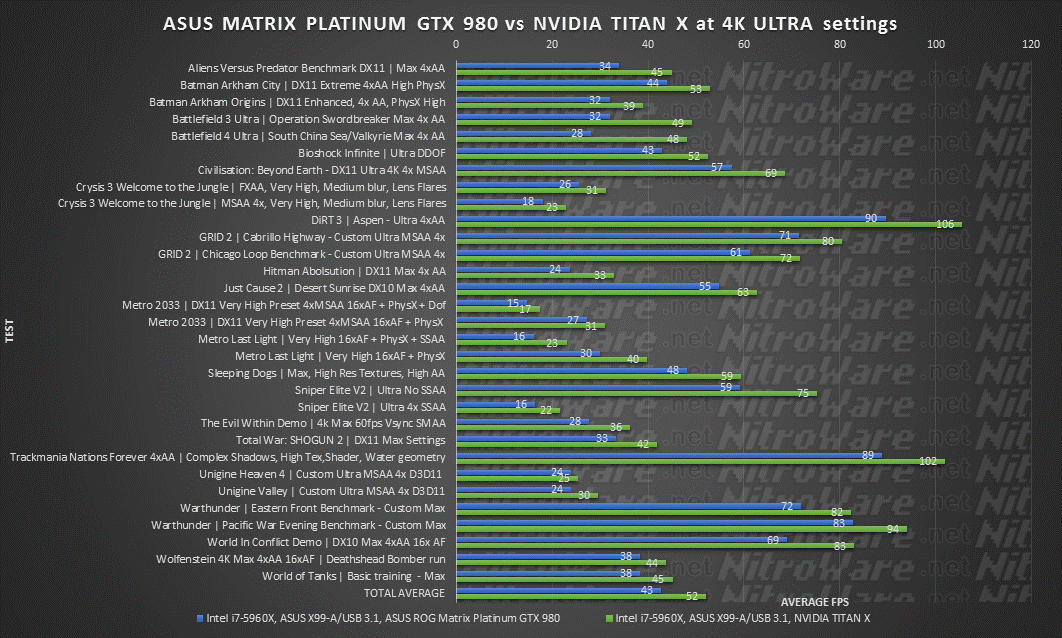
In our worst case 4K benchmarks, Overall TITAN X gives a 20% boost at 4K. Realistically, two TITAN X would give an optimal experience at 3840x2160 Ultra with Anti-Aliasing.
What we see here is that despite our large 12 GB frame buffer, Super-sampling AA is still a massive hit on performance, known troublesome games such as the original editions of Metro 2033 and Metro Last Light still chug along.
A couple of points to consider when looking at our 4K gaming results. Lightly threaded games would benefit from a higher clockspeed CPU such as Intel i7-4790K or a heavily overclocked quad core i7
Simply slightly tweaking the uncore clock speed (the BUS clockspeed on modern CPU), by 0.5 to 1.5 MHz results in an increase of several frames per second in, up to 5 in TOTAL WAR: Shogun 2's CPU benchmark due to the resulting higher overall CPU speed, up to an extra 50 MHz.
Secondly, software is still the limitation, a programmable GPU can only operate as well as its API and middleware, plus the end user application or game. Different game engines behave differently. We wont know the true performance of the TITAN X HARDWARE until we perform further testing with DirectX 12 or VULKAN which are claimed to offer not only significantly better efficiency but better performance.
On a day to day basis, adjustment of game settings, perhaps no AA at 4K should yield a great 4K gaming experience on TITAN X
Sleeping Dogs performance at 4K with varying levels of Anti-Aliasing
The original release of Sleeping Dogs from United Front Games and Square-Enix was branded under AMD's Gaming Evolved marketing program and as such included some graphical features to maximise visual quality.
Optional within the game are HD textures which were later pushed into the remastered version of the game and anti-aliasing levels of normal high and extreme, which combine FXAA and Super-Sampled Anti Aliasing
Sleeping Dogs Anti-Aliasing modes:
- Normal: FXAA Only. Approx 1.6GB Video Memory used with all options maxed out
- High: FXAA High, SSAA Medium. Approx 2.2GB Video Memory used with all options maxed out
- Extreme FXAA High SSAA High. Approx 3.3GB Video Memory used with all options maxed out
The game offers these AA presets only, you canno't individually toggle FXAA or SSAA.
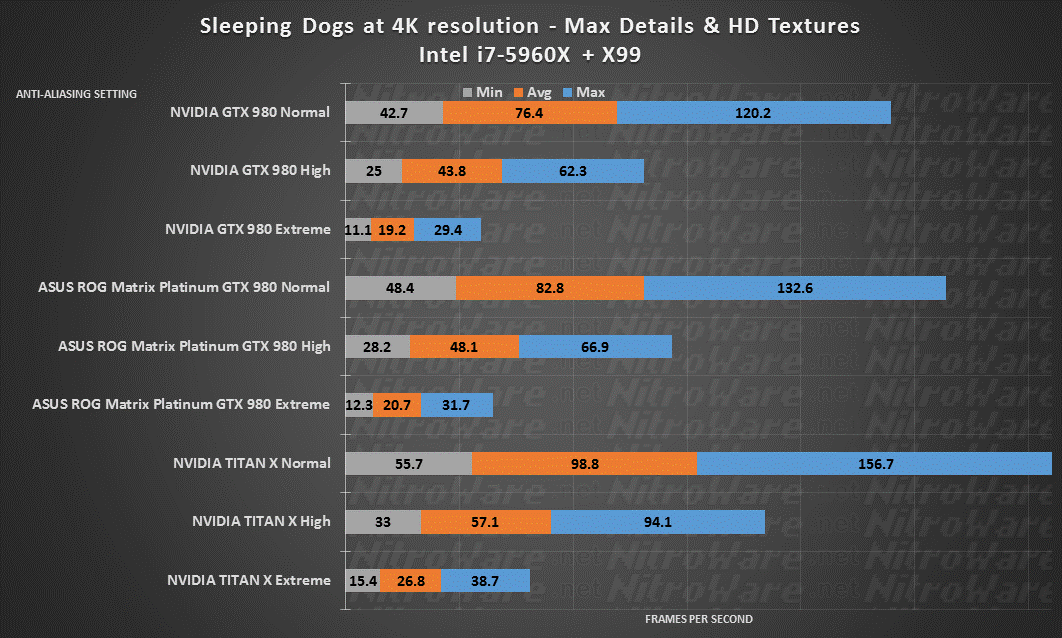
At normal setting, Reference GTX 980 to the over-clocked ROG GTX 980 nets us a 10% gain. ROG GTX 980 to TITAN X nets us another 17% gain, and reference GTX 980 to TITAN X 30% which is what was expected for the TITAN.
On average framerates, we see the same scaling across the different modes and cards.
When testing with extreme AA, TITAN X would hit its power and temp limits, turning GPU boost off
Benchmarks - 1080p and 1440p
Our 1080p and 1440p tests consist of more classical synthetic and real world gaming tests which enable us to compare different platforms (CPU and GPU) easily. We are therefore able to include results for the Radeon R9 290X GPU, AMD's flagship competitor to the GTX 980 and for the time being the TITAN X too.
Due to our 290X sample dying prematurely , we do not have a complete set of competitive scores for it.
Furmark, 3D Mark, Unigine Heaven/Valley
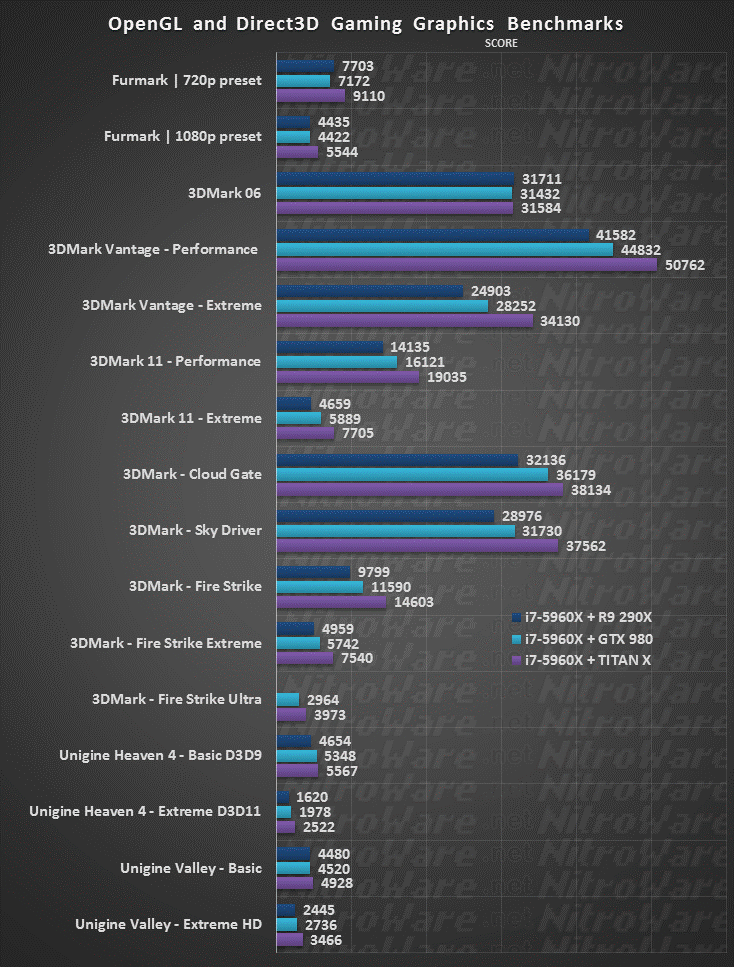
We do not 'play' 3DMark, but the overall performance advantage TITAN X paints a pretty picture (pun unintended), as with our 4K gaming tests, we also see up to 30% increase against the 290X and 20% for the GTX 980. We include Furmark as an OpenGL performance test.
Consider the following when looking at these results.
- GPU memory bandwidth: R9 290X 320 GigaBytes/s, GTX 980 224 GB/s, TITAN X 336 GB/s
- CPU clock speed, Unigine can be sensitive to small changes
- Older versions of 3Dmark are mainly included for reference and should not be used to solely evaluate performance of new hardware, as well as being more CPU reliant.
- 3DMark Firestrike includes a PHYSICS test, to simulate a typical game which combines 3D Graphics and Physics computations.
- 3DMark Cloudgate is intended for 'home PCs', while technically a gaming rig is a home pc, Firestrike and Sky Driver are more suited to DirectX11 compatible gaming PCs
Unigine Valley is not only a beautiful demo to watch but it also quickly and easily bring the GPU up to maximum temperature which helps evaluate thermal performance.
DiRT 3 Performance Scaling
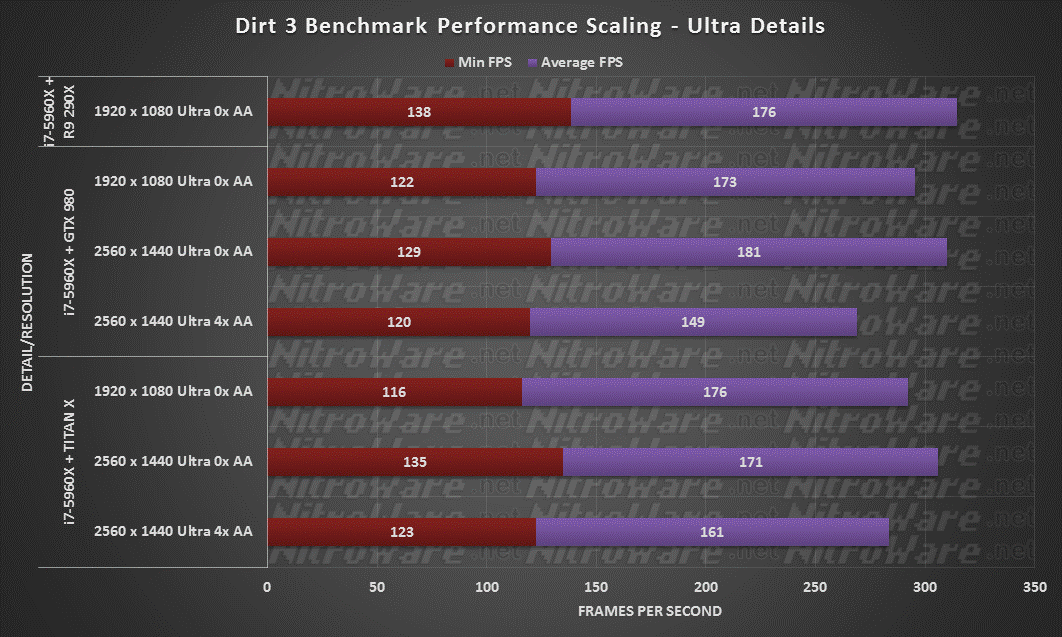
Dirt 3 from Codemasters is their 2nd generation of racing game utilising their EGO engine, incorporating DirectX 11 effects such as lighting, water and crowds. Again under AMD's Gaming Evolved banner the title is well multi-threaded and can utilise up to 8 CPU cores, allocating these to different functions of the game. It also scales well across different resolutions and CPUs making it an ideal test especially as it includes random opponent AI.
Despite this, the benchmark includes a random AI element which alters the result of the race each time the test is run. This and the nature of the game can induce variation into results. Regardless both of NVIDIA's GTX 980 and TITAN X are able to drive minimum of 120 FPS which is desirable for the new 1440p 120/144Hz gaming monitors incorporating smooth motion technology from AMD (Freesync)and NVIDIA (G-Sync), or 3D Stereoscopic gaming.
Batman: Arkham Origins Performance Scaling with and without GPU PhysX
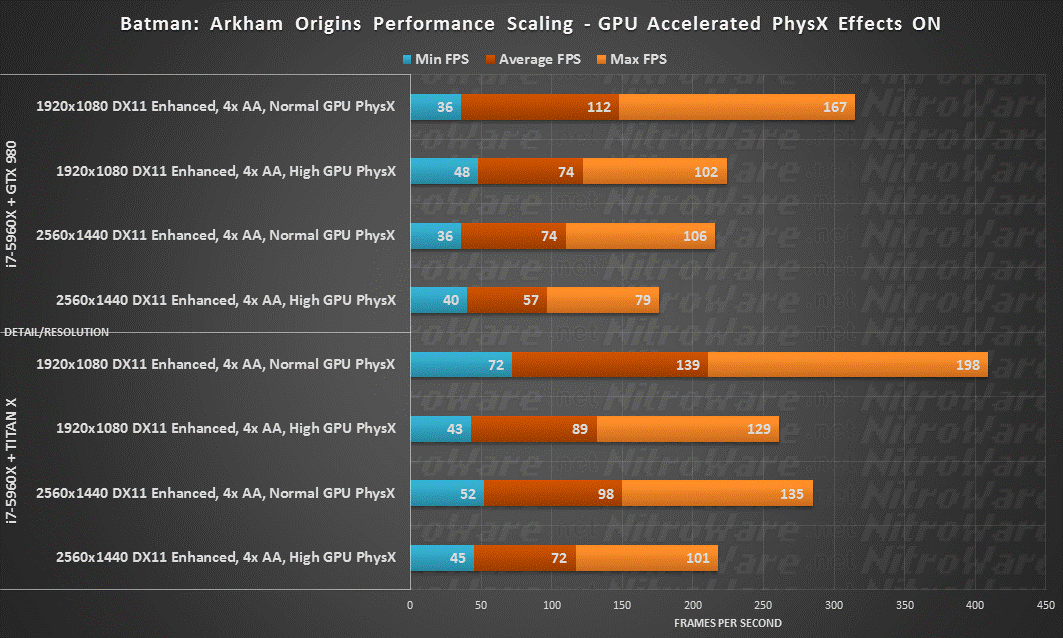
Being an NVIDIA The Way It's Meant To be Played branded title, of course the Batman Franchise of Games includes GPU Accelerated PhysX for NVIDIA GeForce cards.
For Arkham Origins there are three settings, OFF (CPU powered standard Physics only), Normal which gives GPU Accelerated PhysX mainly lots of interactive paper and banners in game and High, which is paper, banners, steam, smoke and snow.
GPU Accelerated PhysX is not free and has a significant performance penalty. Additionally it is not supported on AMD RADEON therefore we need to test multiple combinations of settings. Ideally an owner of a high end GeForce especially our TITAN X would like to play with everything maxed out and at 1440p with HIGH PhysX TITAN X delivers, 20% faster than a reference GTX 980.
We were not able to compare against the 290X here due to card failure.
Things to note was Arkham Origins was developed in-house at Warner Bros Game Studios and not Rocksteady who did the other three games and that even the menu screen for the game is very GPU intensive. Actually playing both Arkham City and Arkham Origins, the use of GPU PhysX effects is quite profound and noticeable such as in missions where you have to deal with ice when chasing the Penguin or back alleys full of all discarded paper flying in the breeze.
Some claim it is just visual eye candy, but being a fan of the series and having equally fully played and tested the batman games with and without extra GPU PhysX it is hard to do without the extra effects.

To be fair to RADEON users and for comparison purposes we also tested with GPU PhysX off. While it had a 30 FPS penalty enabled, we still have similar scaling between GPUs with it off, of 20 FPS.
Bioshock Infinite Performance Scaling
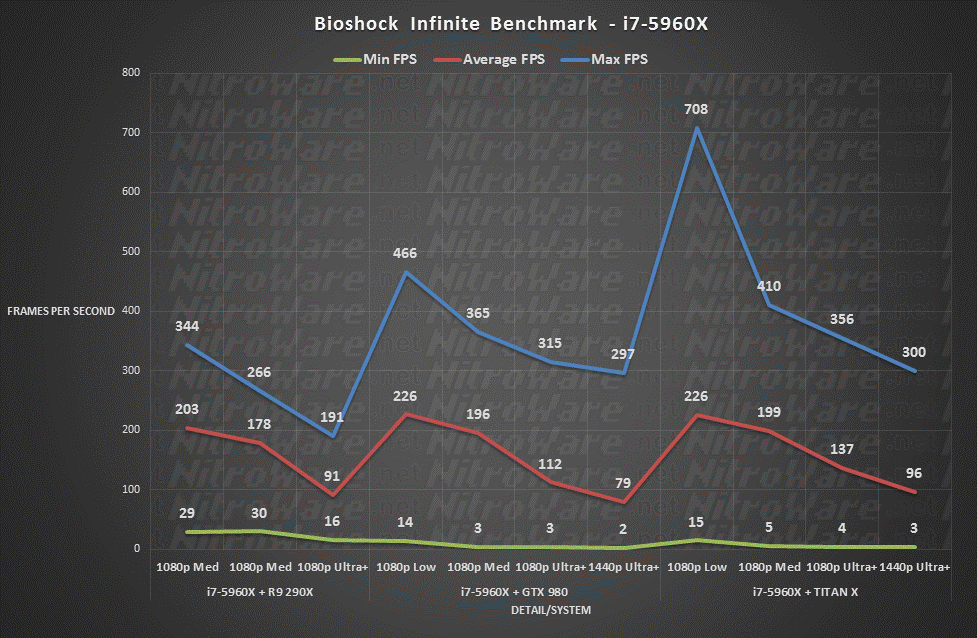
Another Gaming Evolved Title, we are dammed if we use this game and dammed if we don't. Although a popular title and widely used as a test due to its convenient benchmark mode, it has several flaws. Results can be inconsistent, there is no AI in the test it is simply a graphics fly through of popular levels from the game and there are calculation anomalies in the raw test results. Never the less we present Bioshock and likely the last time we use this test for high end PCs before retiring it.
For average, TITAN X delivers against the 290X, again unfortunately no 1440p for 290X due to failure.
Crysis and Crysis 3
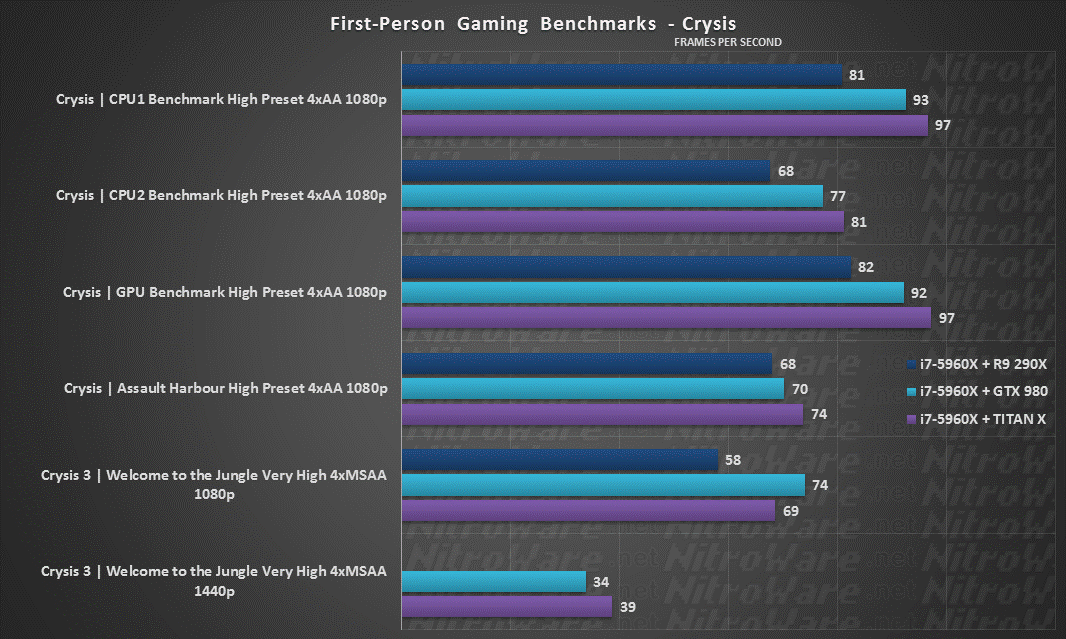
Can TITAN X play Crysis? hell yeah !
Our Crysis tests are fully automated and do not contain enemy AI, only damage physics or are level fly-throughs. Our Crysis 3 tests are manual, actual gameplay with the frame rate measured. This can be inconsistent as no two play-throughs will never be exactly the same. In a way this can be a good thing as its a realistic simulation of actual game play. Despite being 64-bit and DirectX 10 the original Crysis still performs moderately.
We standardise on MSAA for comparability, as Crysis 3 supports multiple types of AA which would be too complex and overwhelming to compare. We wish frame rates were higher for Crysis 3 at 1440p but at this level the effects are outstanding especially for the games age especially grass and foilage. However, Crysis 3 is not really a game were you want low frame rates.
Metro 2033 and Metro Last Light
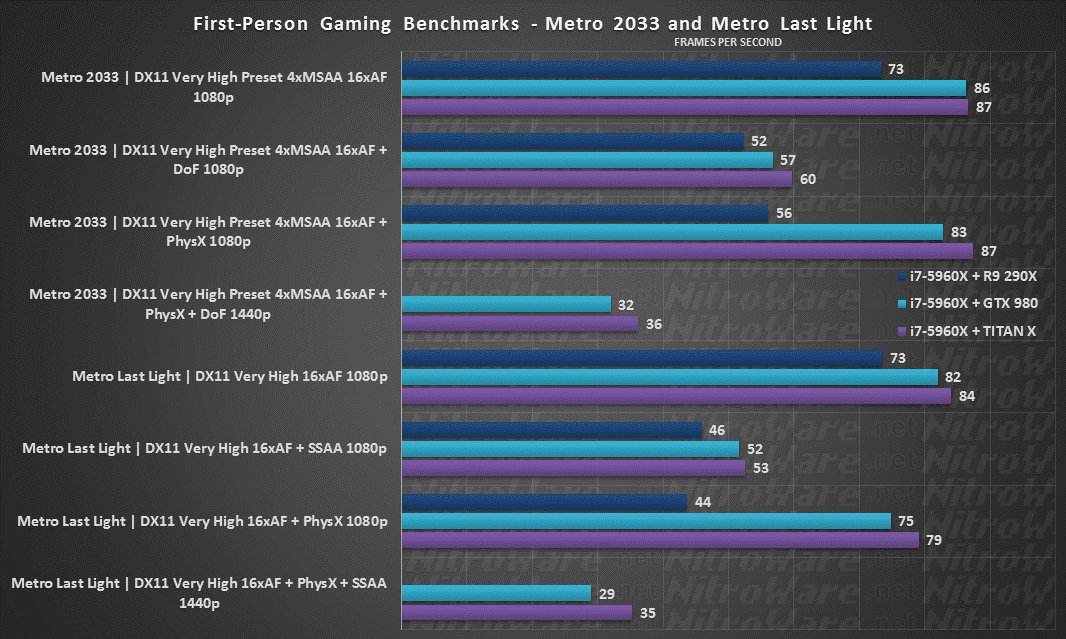
The original editions of both Metro 2033 and its sequel Last Light now share the throne with Crysis as very heavy demanding titles. Their benchmark routines feature AI, physics (GPU accelerated PhysX optional), collision damage and heavy particle effects. Again Super-Sampled AA almost halves the frame rate. The change from MSAA to SSAA between the games is interesting.
29 to 35 FPS at the high end may not seem like much but again that is actually a 20% increase. Both Metro games are NVIDIA logoed and marketed.
Alien v Predator, Battlefield 3, Deus Ex:Human Revolution, Sniper Elite V2
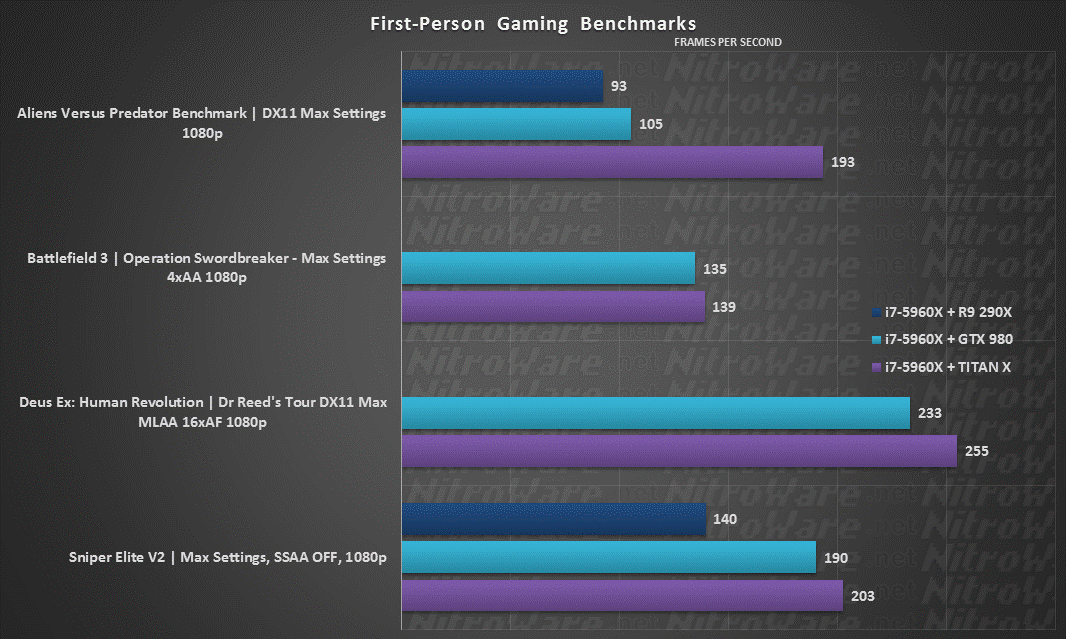
Alien V Predator 2009 is a standalone DirectX 11 benchmark that first debuted on AMD's 'Cayman' Radeon 6900 series GPU. Back then it was an eye-catching demo and still is now especially when scaled up to 4K. The benchmark routine includes scripted AI paths and some collisions.
Battlefield 3: the gold standard in Military First Person Shooters. We loop the start of gameplay in Operation Swordbreaker level through the first firefight manually using actual gameplay and FRAPS. Things to consider are variations in frame rate due to manual play, no two play-through would be the same.
Deus Ex Human Revolution was released in late 2011,and although it was suppose dto be graphically rich at launch things improved quickly and it runs too well these days. We benchmark the introduction of the game, Dr Reed's Tour using manual gameplay. This features character AI but no gunplay and minor collisions.
Sniper Elite V2 ships without a Multi-Sampled AA feature , only Super-Sampling at 2.25x or 4x. We benchmark without SSAA at 1080.
Clearly these older games are outclassed by flagship hardware, although in the case of Sniper Elite based on our 4K benchmark with Super-Sampled Anti-Aliasing which takes a huge performance hit, having a huge FPS number to begin with helps.
Batman Arkham City, Hitman Absolution, Resident Evil 5
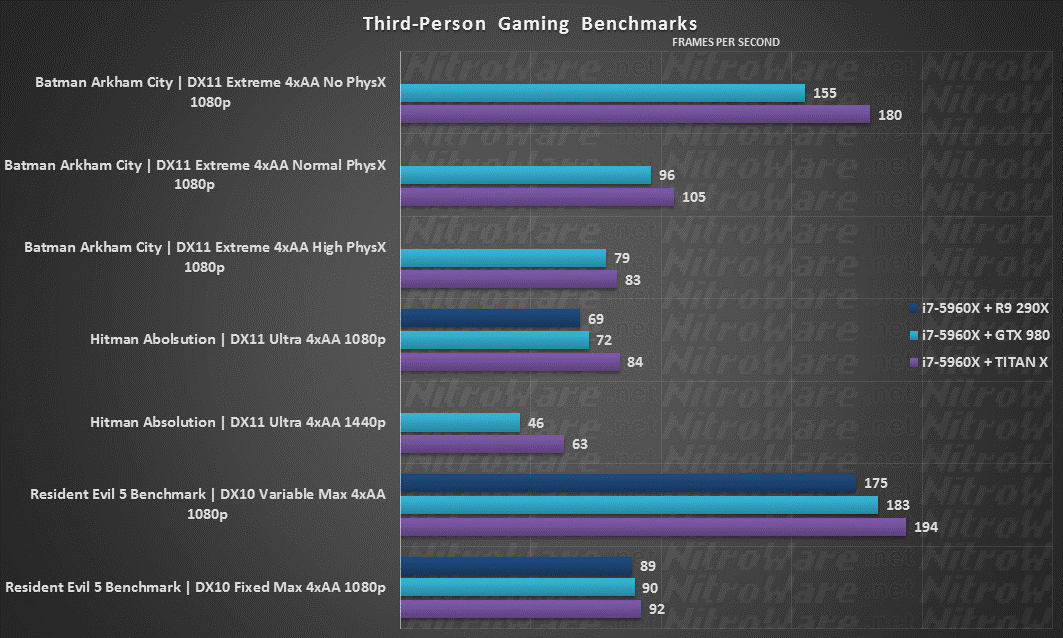
Arkham City was the 2nd in Warner Bros/Rocksteady's franchise of open world/3D all based on the Unreal Engine. Released in the NVIDIA 'Fermi' (GTX400/500 series) and branded under NVIDIA's game marketing program it had spectacular GPU PhysX and DX11 effects for its time yet was made infamous by reviewers for having an unusable DX11 mode at launch. With two sequels since (Arkham Origins and the at the time of this review delayed Arkham Knight), we have scaled back our testing of Arkham City and moved on to the newer titles in the franchise.
Hitman Absolution was a showcase title for AMD utilising GPU compute for some effects and combines both FXAA and MSAA. It's benchmark loop features heavy particle effects and Crowd instancing, despite sometimes giving inconsistent results, TITAN X gives a huge boost at 1440p which is what we want to see.
Resident Evil 5 is an older DX10 title which allows us to compare relative 3D performance across a range of entry to high end devices. You would typically run such titles in 'locked' frame mode, so it is important to achieve a constant frame rate, ideally 60 FPS at your chosen resolution.
Trackmania Nations Forever, Sleeping Dogs, Just Cause 2, Warthunder, Star Swearm
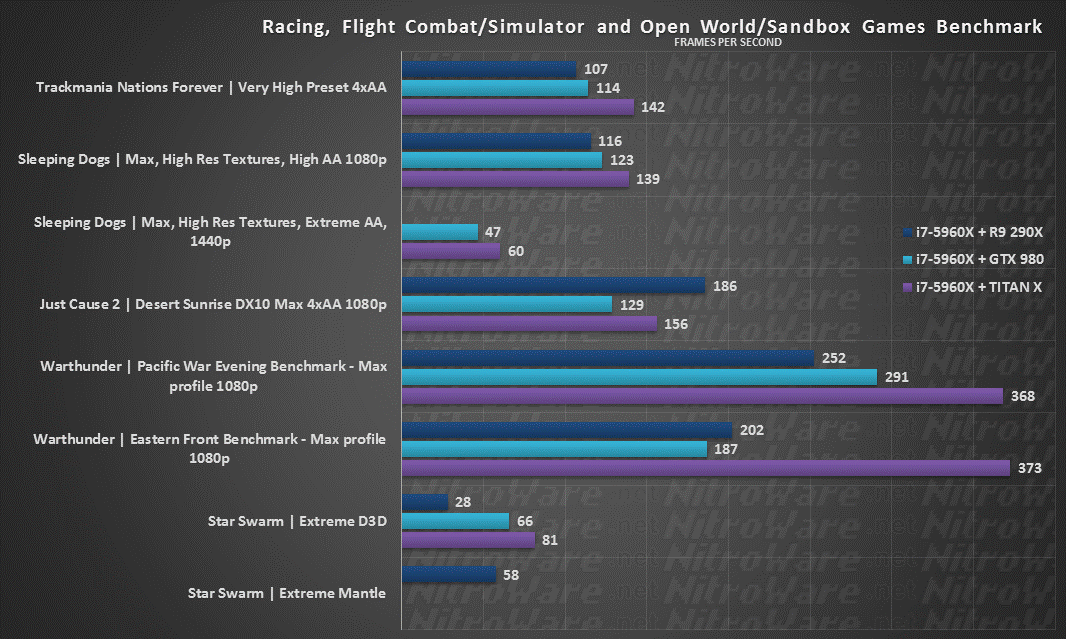
Trackmania is a DX9 free to play single and multi-player racer that is popular online and in professional e-sports. Being older (the newer commercial titles in the franchise have updates) it is not fully optimised for new hardware yet can still scale to 4K fine. TITAN X gives us the promised speed-up, though even it can only just achieve 144 Hz.
We talked about Sleeping Dogs under our 4K coverage but here we show 1080p and 1440p performance, Scaling is consistent between our three top end GPUs. Performance at 1440p Extreme is satisfactory and of course we could scale back down to Normal AA as shown in our 4K benchmark.
Just Cause 2 being an NVIDIA title includes some GEFORCE ONLY graphics features such as Bokeh filter and these may affect the frame rate. We test with these on as a worst case scenario and that the settings don't line up properly between GPUs. For such an 'old' title, it can correctly see our 12,288MB of video memory.
Recently endorsed by NVIDIA for including effects from its Gameworks library, Warthunder - a free to play air warfare title from Gaijin Entertainment presents us with a large number of graphical options. For 1080p we stick with the max preset for comparability,noting that max still does not fully utilise all the possible effects and details possible. At 4K we test with custom settings that do max these out.
Star Swarm is a benchmark created by Oxide Games to demonstrate AMD's 'close to the metal' MANTLE API which delivers improved efficiency when combined with their Radeon GPUs. Focusing on large numbers of star ships in combat, ironically a 290X and Mantle is outclassed by a GTX 980 in D3D mode, let alone the TITAN X.
Having said this, newer AMD drivers may have improved things but as we stated earlier our 290X couldn't take the stress of heavy benchmarking and died.
Street Fighter IV, Total War: SHOGUN 2, World In Conflict, Civilisation: Beyond Earth
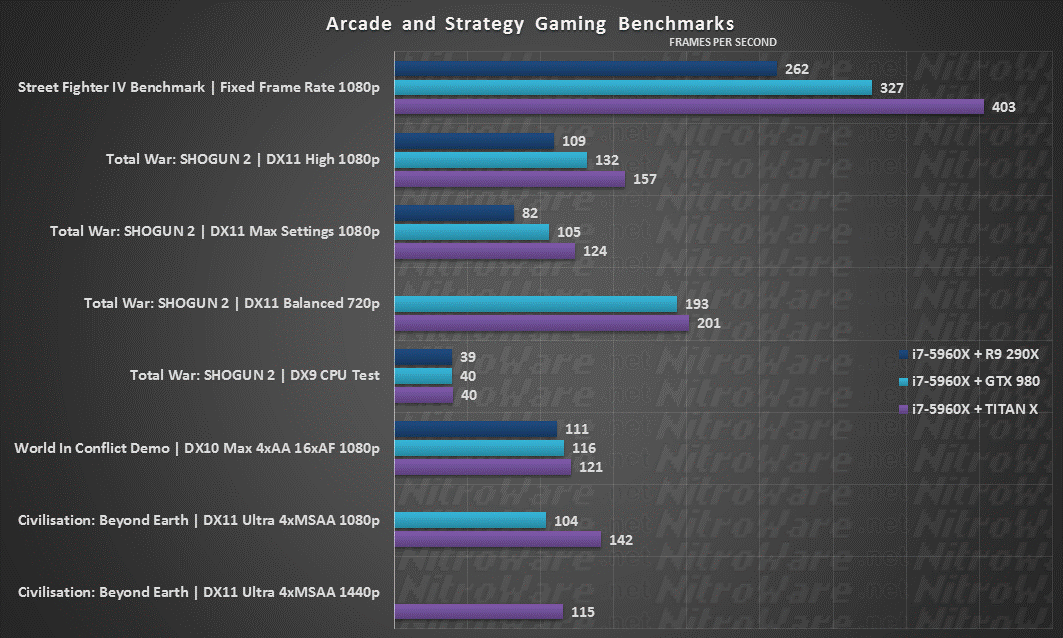
StreetFighter IV was designed for older hardware and fixed 60 FPS but can demonstrate to us the threshold of graphics throughput when we remove the frame rate lock/limiter. Ludicrous speed is achieved. For curiosity we tried at 4K, 8X MSAA and additional Ink effects and we still achieved 300 FPS.
The DX11 title SHOGUN 2 from Sega and Creative Assembly lets us compare different platforms by using its various benchmark profiles. The benchmarks include heavy unit AI and object instancing. Although focusing on GPU performance, we include the CPU test to show different motherboards are within spec, as we used two different X99 motherboards from Gigabyte and ASUS for this review.
World In Conflict was an early DirectX 10 RTS which incorporates heavy enemy AI, object destruction and particle effects. Both the WIC and SHOGUN 2 benchmarks replicate actual gameplay rather than just a fly-through and despite its age WIC is still some effort for our huge GPUs.
CIV:Beyond Earth is the new kid on the block here which was designed to test and showcase Mantle. Regardless its benchmark performs great on TITAN X in Direct3D mode.
GPU Compute and Professional Graphics Benchmarks
GPU Compute synthetic benchmarks using CUDA OpenCL and DirectCompute
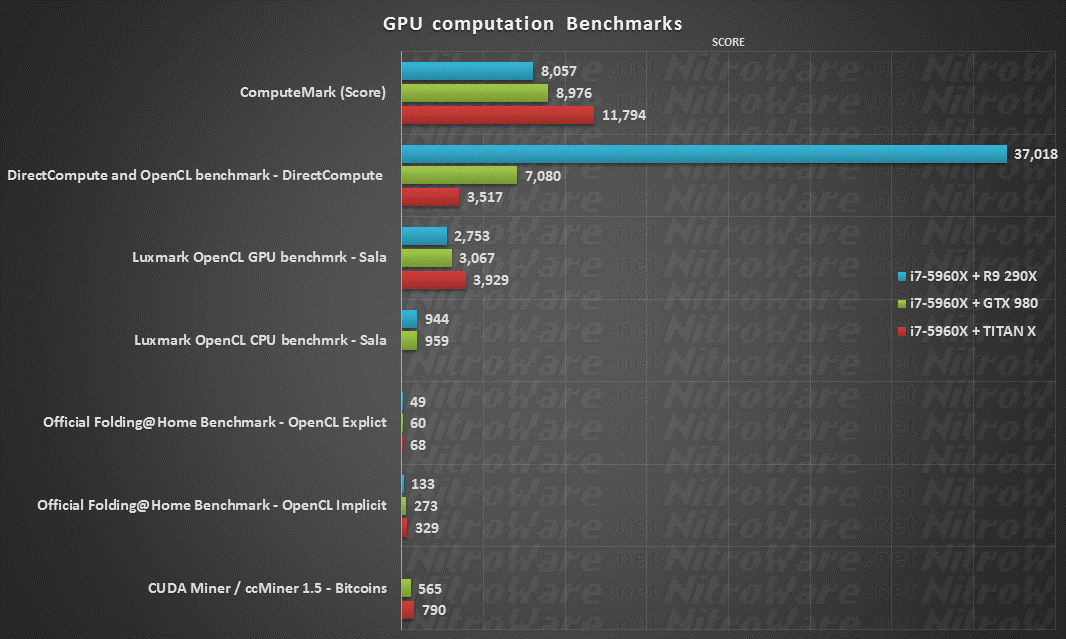
Computemark is a set of synthetic benchmarks designed to make good use of GPU computing, consisting of fractals,fire and other complex structures. Again TITAN X performs well up to 30%.
DirectCompute benchmark has always favoured AMD cards for some reason, their driver design is different as is their compute cores, focusing on horsepower rather than speed or efficiency, where as GeForce cards favour CUDA instead of OpenCL here.
Luxmark is a industry favourite, with a TITAN X providing 4x the better performance than our 5960X CPU.
Folding@Home Benchmark is optimised for CUDA but we can't use this feature due to outdated CUDA support for Maxwell, but OpenCL works and lets us compare across different OpenGL hardware.
Both CUDA miner and its replacement from the same developer ccMiner support Maxwell GPUs, with ccMiner fully supporting the 900 series and TITAN X. 790 Mhash/s for Bitcoin is actually the worst case here, as throughput starts out at around 900 Mhash/s and reduces once the GPU's temp and power limits are reached. With overclocking 1000Mhash/s would be a remarkable number to achieve for a single 250 watt GPU !.
While CUDA Miner did work on GTX980, on TITAN X it's auto configure routine would fail, causing a infinite loop. Amusingly this loop would utilise all the cards 12GB memory, which we had trouble filling otherwise using normal applications ! ccMiner is from the same developer and more optimised for Maxwell GPU so we naturally recommend this instead.
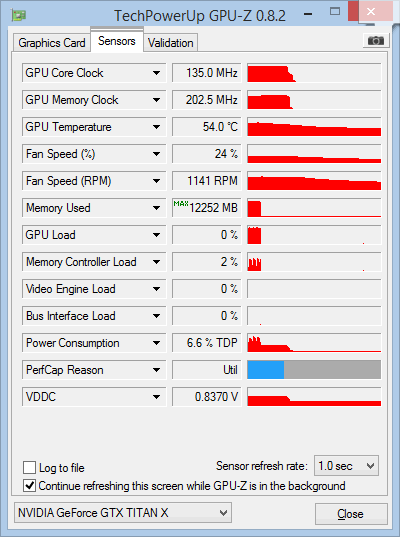
Photoshop, Blender
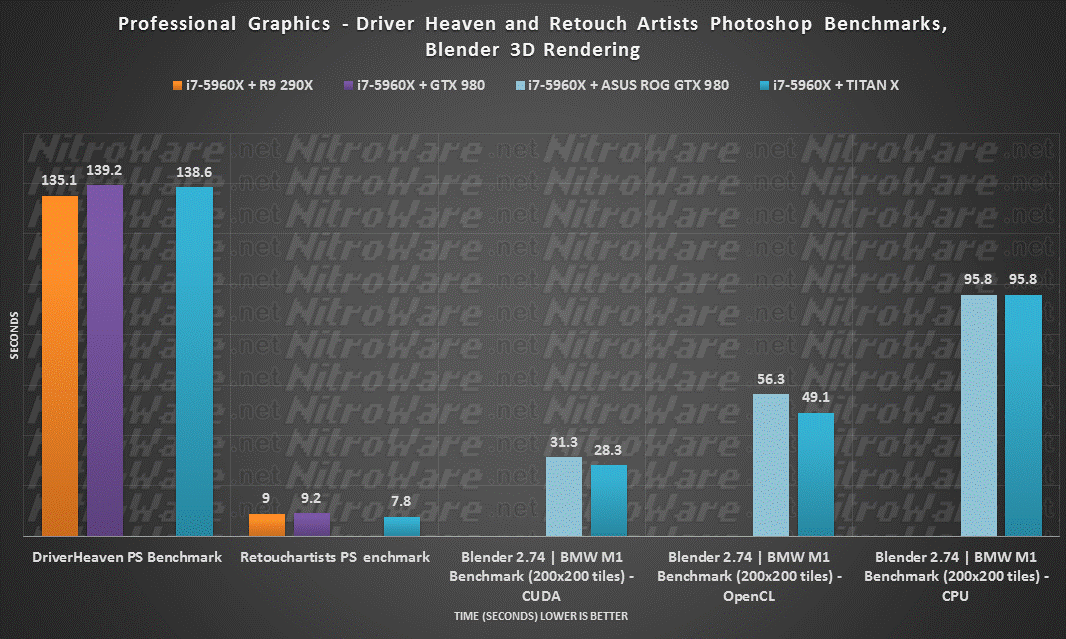
Photoshop CC relies on OpenGL heavily for image manipulation,compositing and rasterisation. With multi layer Full HD resolution documents open, GPU temps can rise to the mid 60s as there is a mild load.
However, Driverheaven's Photoshop benchmark focuses on filters and image size that are mainly CPU bound so GPU has a minimal effect here. Retouchartist's benchmark at least performs image manipulation (resizing) which can take advantage of the OpenGL GPU hardware.
We have tested Blender before but its only since this review we found the optimal settings which REALLY showcase the power of GPU computing and hardware acceleration. Despite the BMW M1 benchmarking claiming 'do not touch any settings', to get the optimal performance we MUST set the tile size to at least 200x200, versus the 100x27 default.
OpenCL gives us a 2x speedup over 5960X 8 core/16 thread CPU rendering and CUDA with TITAN X gives us a 3x speedup, and more importantly a boost over GTX 980. More the reason a GPU is needed for professional content creation.
SPEC Viewperf 11, SPEC Viewperf 12
SPECViewPerf is a sample collection of professional applications from the design, engineering, medical and science fields, used to determine performance for these specific demanding applications.
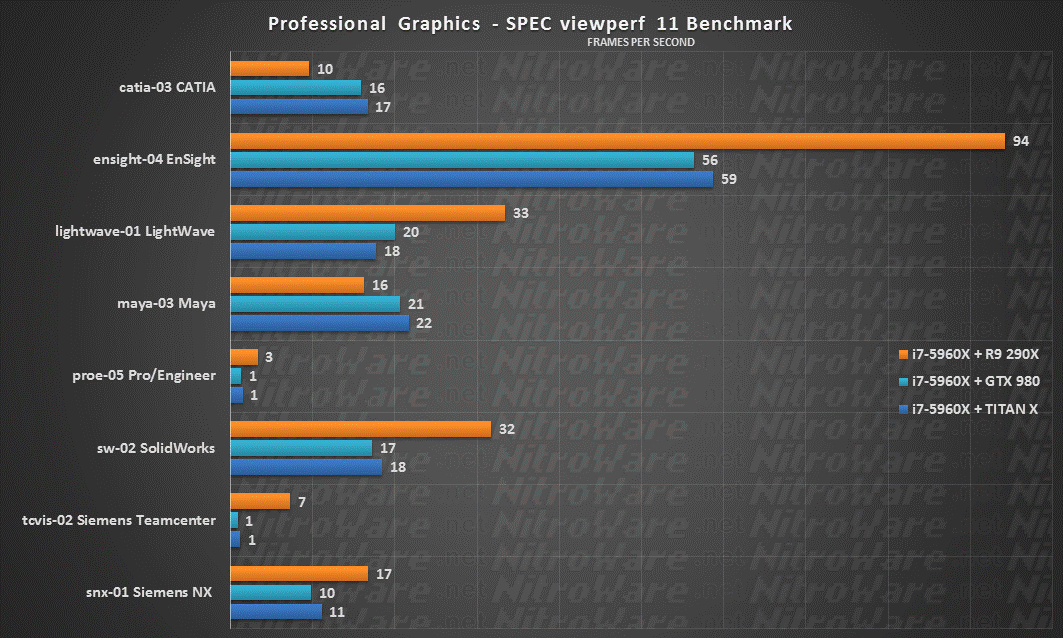
We run SPEC 11 with 4x MSAA ON at 1080p which is not the default, default is no Anti-Aliasing. Things to consider: Viewperf 11 is slightly older now and AMD R9 290X has significantly higher double precision floating point math performance, 704 Gigaflops versus 220 Gigaflops. Additionally it is recommended to use a Quadro or FirePro GPU with these professional apps, not a consumer GeForce or Radeon. Some apps now support consumer GPUs eg Maya so this is why we continue with these professional grade tests.
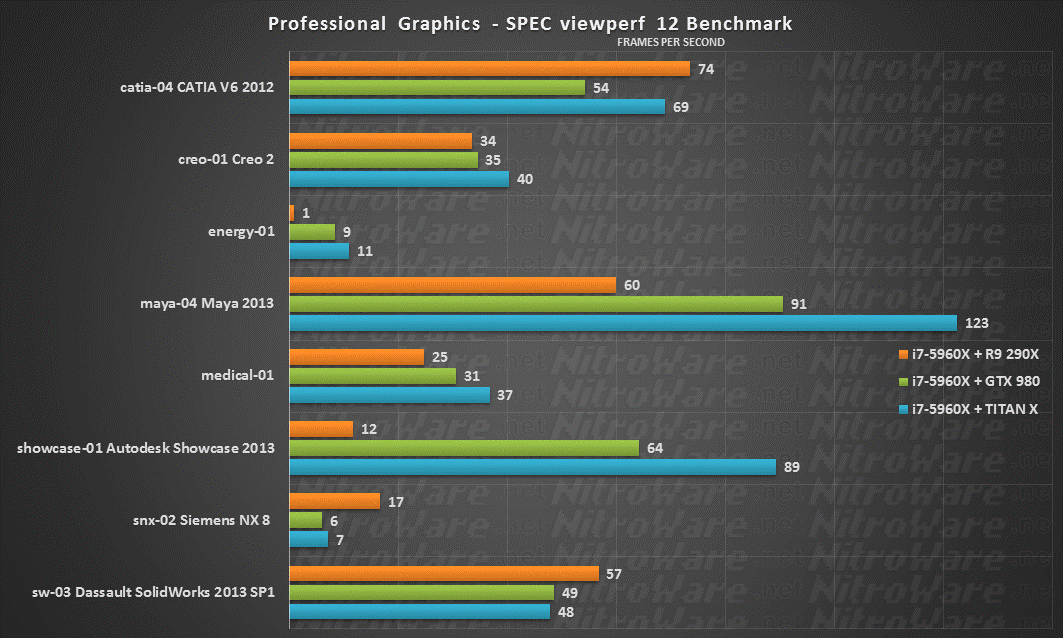
SPEC 12 changes things slightly, updated tests and engine. it no longer offers the Anti-Aliasing switch so we run it at default 'official' test mode
Energy and Medical tests are in-house simulations created by SPEC organisation to demonstrate those use cases, they are not actual commercial/professional applications. The other tests are especially CATIA, Maya, Siemens and Dassault. While the Cheaper R9 290X performs well in some tests TITAN X just runs away in others.
Maxon Cinebench R11.5 and R15
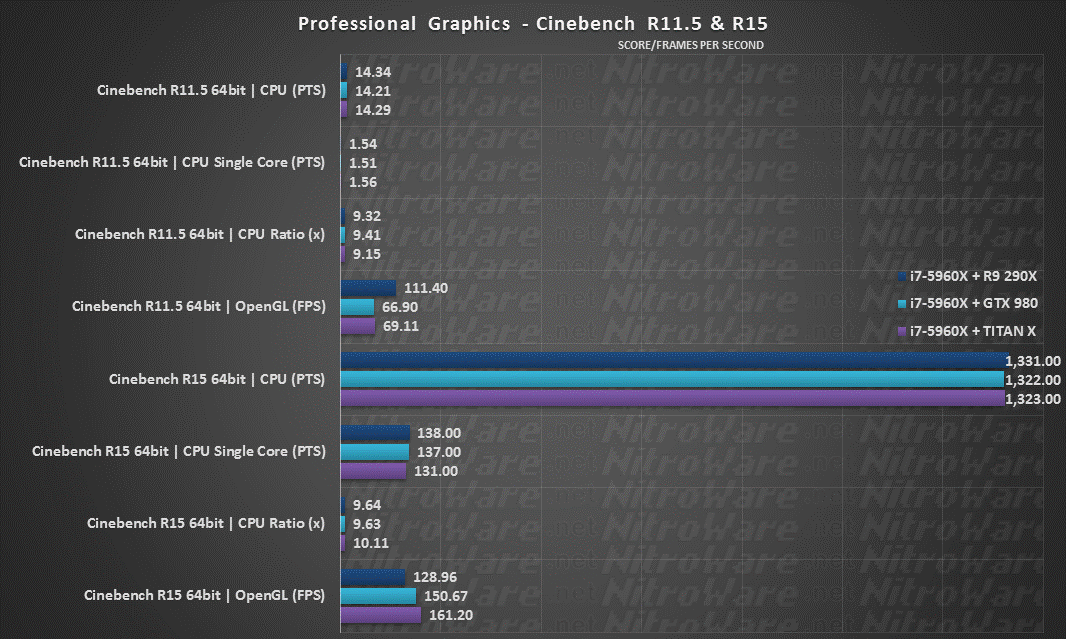
While the Cinebench benchmark has been widely used and respected for years thanks to its decent multi-threading, its appeal was slightly limited as it only served as a performance test for people using Maxon's' Cinema 4D 3D modelling software. Additionally for the older versions of Cinebench, OpenGL rendering performance seemed tied to clockspeed with poorer multi-threading capability, fixed in newer versions.
Adobe has begun to bundle Cinema 4D Lite with its popular AfterEffects CC software so now Cinebench has further usefulness.
We provide this test as a reference for OpenGL performance. CPU scores are included to show that different motherboards used are within performance tolerance. TITAN X could be faster but does what it needs to do here.
Adobe AfterEffects CC 2014
Adobe introduced support for CUDA (GPU) Acceleration of 3D Ray-Tracing using NVIDIA's OPTIX library. Kepler cards are supported however Maxwell are not. To get around this Adobe have recommended the recently bundled Cinema 4D Lite which is not GPU hardware accelerated.
Adobe claims the feature (CUDA Ray-tracing)is old and outdated. We reached out to NVIDIA for their side of the story but they did not comment.
Overclocking
GTX TITAN X is currently only available as NVIDIA designed and built boards from NVIDIA directly and from its Add-In-Board partners. Since the boards are standardised the overclocking headroom can be 'guaranteed' with up to 1400 MHz from the 1000 base being described as possible.
Since GeForce cards have GPU boost, we can only set the base, not the boost clock. We tested a 200 MHz offset for the GPU core and memory BASE clocks, plus 110% power limit and 91C temp limit which is the maximum allowed for TITAN X. The 200 MHz offset will give us near 1400 MHz when boost is in effect.
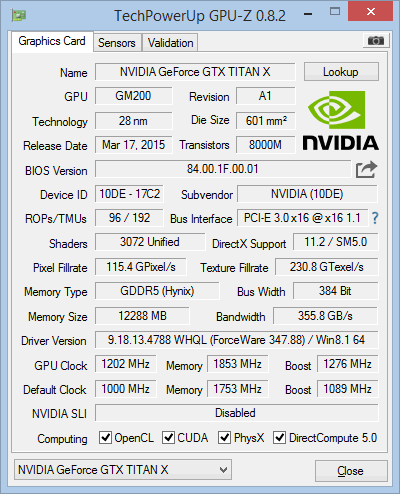
We see 9-13% increase in Firestrike scores, which is fine given TITAN X's performance advantage over any GTX 980 anyway. This is just an example of TITAN X's overclocking capabilities. We are limited by power and heat, so it will be interesting to see how far the GPU can go under water or sub-zero cooling, especially when some pro-overclockers modify the power system to deliver more power.
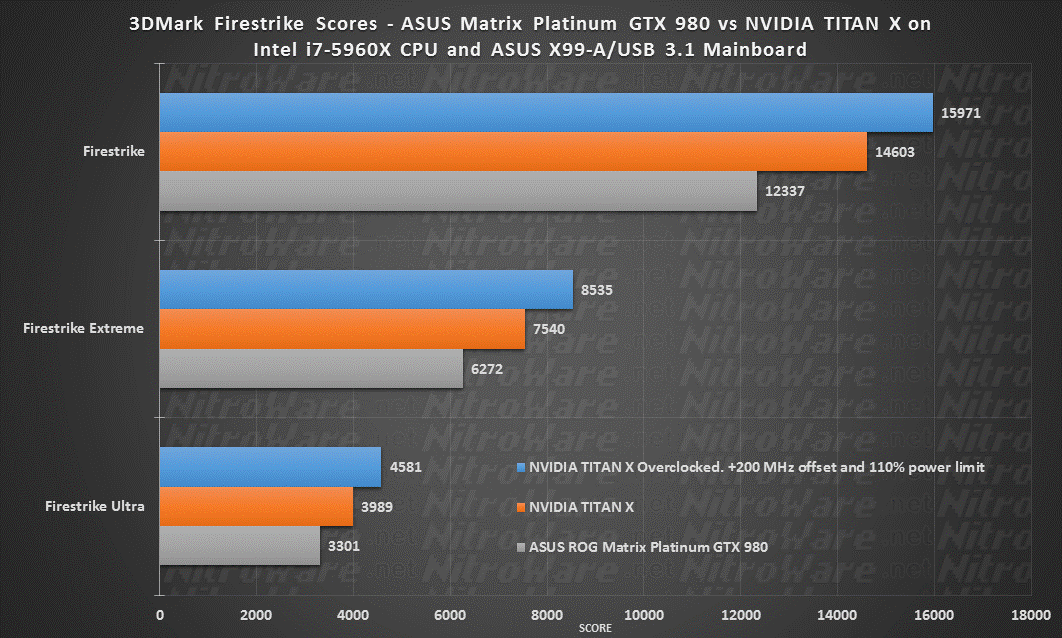
Power Consumption and Temperature
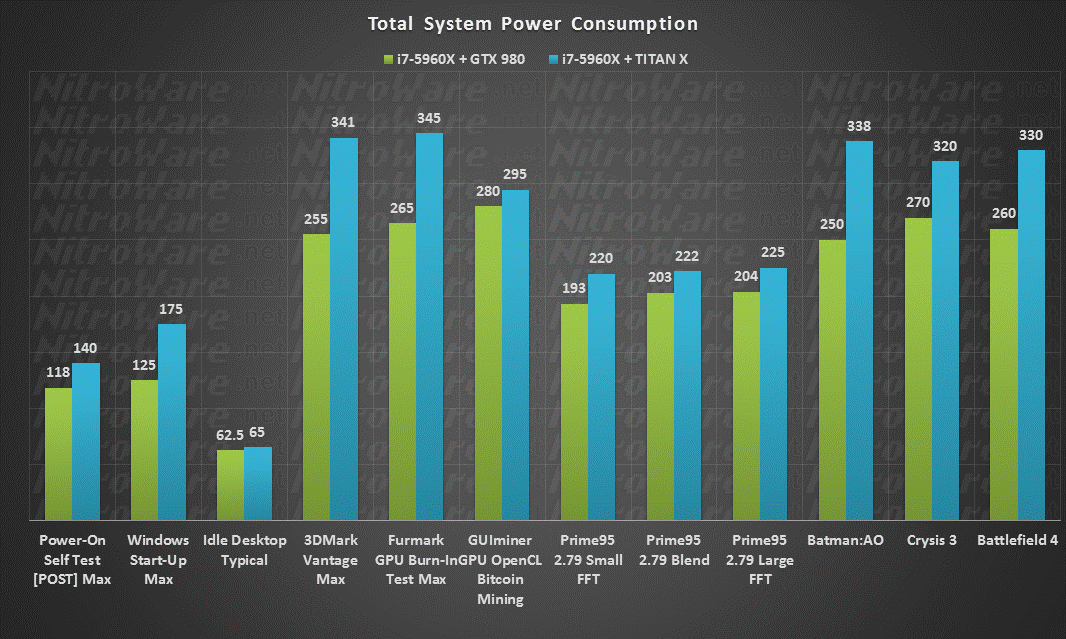
We provide a number of reference points to compare compare the reference NVIDIA GTX 980 and GTX TITAN X power draw. Idle, CPU only, GPU only and in game (blended use). Unfortunately we had to change X99 motherboards between the comparisons. The newer ASUS mobo has slightly less devices on-board, but both setup use the same PSU, Liquid Cooler, storage and Memory Speed/Timings.
We saw up to 85C in Unigine Valley and Battlefield 4 did not notice any thermal runaways with TITAN X (nor the ROG MATRIX). In comparison the ROG MATRIX 980 reached 73.3c in FireStrike Ultra. In Batman and Unigine valley we saw the same thing, with the ROG GTX 980 holding steady at around 69 to 71,73C compared to 80+ for reference GTX 980 and TITAN X
At idle, both cards run their fans at around 1000 RPM, they do not support the silent idle feature of aftermarket cards such as certain after-market GTX 960/970/980 boards.
Pricing and Availability
Writing this review ahead of Jensen Huang's announcement of TITAN's pricing at GTC makes discussing price difficult
For competitive reasons, NVIDIA did not provide the press with pre-release pricing. At time of writing the review we had no idea of pricing, apart from a rumour of $1349. What NVIDIA did tell us is they wanted to change the positioning of TITAN by removing the high speed double precision floating point capability for GPU computing.
In theory this would enable two things. Since TITAN is no longer cannibalising Tesla sales, NVIDIA can afford to drop the price of Titan, bringing it in-line to gaming class graphics card pricing rather than professional. This would allow more users to acquire the performance of Titan X while at the same time NVIDIA can protect its product segments.
This is a GOOD thing, unfortunately for the very small niche who need double precision yet elected to buy a titan because it is cheaper than a high end Tesla.
NVIDIA holding specs and pricing extremely close to their chest tells us that something is going on and this is no ordinary GPU launch. The GPU wars are back on and either green or red blood is to be spilt.
We predicted that Titan X would have a cheaper, competitive price akin to what 295X2 currently sells for (US $699 and above) and of course, higher than what the 980 RRP is.
At time of writing, with a review embargo in place and no visibility to possible pricing we can only speculate on pricing strategy.
There are two scenarios possible.
- GTX 980 remains at 549 RRP and TITAN X launches anywhere between 699 and 999 US RRP
- GTX 970 and 980 gets a pricec ut to bring them in-line with AMD R9 290/290X and TITAN X gets the $549/599 price point. The controversy over GTX 970 would have had a small part to play here.
Unfortunately, neither of these scenarios played out and the TITAN X was announced by NVIDIA CEO Jensen Huang at their GTC 2015 conference keynote for US $999. This is less than the rumours of 1349 and has been a price used for older flagship GPUs. We feel the card is worth more along the lines of 699 to 799 not 999 based on TITAN X's relative performance to GTX 980 but we can accept US $999 as a 'reasonable' price for the product.
Flagship GeForce cards have always been near $999, going back fifteen years to the GeForce 3 and beyond.
Actual pricing is resonable compared to the announced RRP - US 999 at exchange rate, plus 10% tax is AU $1430, cards sell at AUS 1499/1549.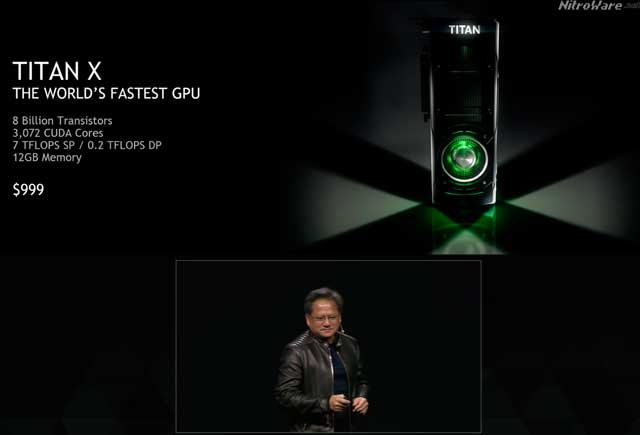
PC Case Gear AU - EVGA TITAN X A$1499
PC Case Gear AU - GIGABYTE TITAN X A$1549
Staticice AU Search - A$1539 and up
Verdict
The most important thing to note is like the original Kepler Generation 'GK110' based 6GB TITAN, the TITAN X is a evolution not a revolution over the GTX980. Having 'only' 3072 cores it is not quite two 980 in SLI, and is closer to 1.5 980s. However, SLI scaling does vary game to game.
While it is disappointing the card isn't any faster than it can be due to thermal and power envelopes (but can be pushed with overclocking), the fact that it is 1.5x a GTX 980 on paper in the same form factor is nothing to sneeze at.
Titan X performed well in our testing and while it could have been faster out of the box, it didn't have to be as it delivers the speed-up expected of it. With some tweaking such as using MFAA or No AA at 4K, performance should be improved finally delivering the experience gamers have been begging for out of a single GPU being smooth frame rates at 4K Ultra resolution.
The Elephant in the room is pricing however not performance. The old Titan and Titan Black were infamous for their pricing, as were the old GeForce Ultra cards. With NVIDIA keeping the price from everyone at the last minute, pricing is and was the major factor here. Since we are mainly focusing on the TITAN X here, we have to consider its merits on its own. There are cheaper ways to get similar performance with multiple cards but each has caveats.
A Note on our benchmark testing
We tested 'worst case' performance at 4K resolution with MSAA 4X and where applicable, maximum GPU PhysX enabled. This gives us a baseline to work off, to determine which features in a particular game are crippling performance. Our 8 core 5960X Intel i7 also has a slower multi-core clock speed compared to some of Intel's i7s which have less cores. Lightly-Threaded games will suffer from the clockspeed deficit.
Additionally, once more applications supporting (Maxwell) CUDA 5.2, DirectX 12 and enabling features such as MFAA or VXGI will open up more performance.
Also a single 4K (3840x2160) 3D scene with 4x Multi Sample Anti Aliasing (MSAA) typically uses under 4 Gigabytes of Video Memory and it will take some effort or multiple Ultra HD screens to fully utilise the 12GB capacity, something which will be detailed in subsequent reviews. For our launch review we just went with the standard testing.
Pros
- TITAN X provides a reasonable speed-up over a GTX 980 in the same physical form factor
- Up to 7 TFLOPs from a single GPU, or 8 when overclocked.
- Power requirements are reasonable and do not require an extreme Power Supply
- Fan noise is comfortable and temperatures are controlled
- Future proof 12GB Frame Buffer, especially for DX12 and VR applications
- NVIDIA's attention to detail regarding all aspects of board design
- Best available single GPU board at time of writing
Cons
- A single Titan X board is still not quite enough for 4K 60 FPS Ultra with AA across a variety of games.
- Aesthetic brand ID doesn't tell your friends that you have the 'fastest GPU in the world', Titan branding hidden from view.
- Priced higher than delivered performance increase
- GPGPU students or enthusiasts needing higher than 1/32rd performance double precision math are better served by older Titan/Quadro/Tesla products or AMD Radeon.
- Lack of backplate may not be to the taste of some
- Difficult to determine if the updated components have a positive effect, power limit is set to only 110% (275 Watts)
- AMD are supposed to have a much more powerful GPU due this year.
- Full Capability of the TITAN X reliant on DirectX 12/VULKAN and updated CUDA applications.
The TITAN X is for a particular set of users. Those who do not or can not use SLI, Those who need a single card with a large frame buffer, those which a single GTX 980 is not enough and some students or developers who practice GPU computing.
If you are a typical gamer/enthusiast, your needs may be best met with regular GTX 980s, especially some of the top overclocked models such as the ASUS ROG Matrix GTX 980 board we used in this review, which is 'only' a 2 slot model and uses 2x 8pin power sockets.
Overall, TITAN X is an impressive feat of engineering but at US$999 it is not for everyone. We are keen to see what a dual GM200 TITAN replacement for the Dual Kepler TITAN Z or a 'GTX 980 Ti' may deliver.
Although US$999 is a traditional price for a flagship GPU, the TITAN X performs well enough that those who can afford one or more should be proud to own the TITAN X.
